Crocodile
Crocodylus acutus
Known to eat pebbles to aid digestion and buoyancy!
Advertisement
Crocodile Scientific Classification
- Kingdom
- Animalia
- Phylum
- Chordata
- Class
- Reptilia
- Order
- Crocodilia
- Family
- Crocodylidae
- Genus
- Crocodylus
- Scientific Name
- Crocodylus acutus
Read our Complete Guide to Classification of Animals.
Crocodile Conservation Status
Crocodile Facts
- Prey
- Fish, crustaceans, deer, buffalo
- Name Of Young
- Hatchling
- Group Behavior
- Social
- Fun Fact
- Known to eat pebbles to aid digestion and buoyancy!
- Estimated Population Size
- Unknown
- Biggest Threat
- Habitat loss and hunting
- Most Distinctive Feature
- Eyes and nostrils located on top of the head and snout
- Other Name(s)
- American crocodile, Orinoco crocodile, Freshwater crocodile, Philippine crocodile, Mexican crocodile, Nile crocodile, New Guinea crocodile, Mugger crocodile, Estuarine crocodile, Cuban crocodile, Siamese crocodile, Dwarf crocodile, Slender-snouted crocodile
- Incubation Period
- 3 months
- Age Of Independence
- 1 - 2 years
- Habitat
- Rivers, lakes, marshes, lagoons, mangrove swamps and estuaries
- Predators
- Humans, Large felines, Birds of prey
- Diet
- Carnivore
- Lifestyle
- Nocturnal
- Common Name
- Crocodile, Croc
- Number Of Species
- 13
- Location
- North, Central and South America, Africa, Asia, Australia
- Slogan
- Have changed little in 200 million years!
- Group
- Reptile
View all of the Crocodile images!
Quick Facts:
- Unlike other reptile species, crocodilians are archosaurs which is an ancient group of reptiles that also included dinosaurs.
- Crocodiles bask in the hot sun all day to absorb enough warmth to last through a night of hunting and feeding.
- Social animals who often hunt in groups, crocodiles have the ability to communicate with each other by hissing, chirping, and bellowing. Baby crocs can emit a high-pitched scream when in distress.
- Crocodiles can live up to three years without eating.

Crocodiles are one of the most well-known and fearsome animals in the world and are considered apex predators. Their powerful bodies, strong jaws, and immense speed and agility along with their unparalleled stealth, have led to them being one of the world’s top predators in their natural environments.
Types
- Saltwater crocodile (Crocodylus porosus): Once endangered, this marine monster has since staged an impressive comeback. Known for a penchant for ambushing its prey, it is capable of growing to 20 feet in length and weighing over 4,000 pounds. It is also the largest reptile on the planet and generally has dark green scales, although they may also be tan, or almost black in some cases. The giant reptile can be found in Australia, India, and Micronesia.
- Nile crocodile (Crocodylus niloticus): This reptile is known for its extreme aggression and thick scaly skin. It also has a remarkable ability to clamp down powerfully with its jaws for lengthy periods of time. Its favorite hangouts include lakes, rivers, and swamps and it can generally be found in African regions south of the Sahara and parts of Madagascar.
- American crocodile (Crocodylus acutus): The only crocodile apart from the saltwater crocodile to have an affinity for saltwater, this species can be found in Florida, Mexico, Peru, and Venezuela.
- Hall’s New Guinea crocodile (Crocodylus halli): The giant reptiles can be found in the southern part of New Guinea where they prowl in estuaries, lakes, and rivers.
- Orinoco crocodile (Crocodylus intermedius): The largest reptile in the Americas, this crocodilian is known for its pale hide and occupies the Orinoco river Basin in Colombia and Venezuela.
- Freshwater crocodile (Crocodylus johnstoni): Unlike their saltwater cousins, these reptiles thrive in freshwater and only reach 3 metres and 220 pounds at the maximum. They do live side by side with salties, although they’re no match for the former.
- Philippine crocodile (Crocodylus mindorensis): These freshwater crocodiles have golden brown scales that darken with age. They play a key role in maintaining healthy fish stocks in their environs and can grow slightly over 8 feet while weighing a maximum of 200 pounds.
- Morelet’s crocodile (Crocodylus moreletii): These reptiles which have webbed posterior feet are rather fast runners. They are recognizable by their dark scales and broad snouts.
- New Guinea crocodile (Crocodylus novaeguineae): A separate species from the crocodiles which lie south of the island’s central rige, these reptiles which are found in the north are nocturnal. They have a tapered snout and grey scales.
- Mugger crocodile (Crocodylus palustris): Known for its light olive coloring, this crocodile can be found in India, Iran, Nepal, Pakistan, and Sri Lanka. It also has a habit of burrowing into the mud to escape scorching temperatures and is the crocodile with the widest snout.
- Borneo crocodile (Crocodylus raninus): Found in Borneo, as its name suggests, this species continues to remain something of a mystery to experts.
- Cuban crocodile (Crocodylus rhombifer): Highly intelligent, long-limbed, and fond of land, this crocodile cooperates with other members of its species when hunting. Its numbers, however, have plummeted owing to hunting.
- Siamese crocodile (Crocodylus siamensis): This species comes with scales ranging from dark to pale green. It is capable of growing to a maximum of 13 feet and 770 pounds.
- West African crocodile (Crocodylus suchus): With scales which range from dark to pale, this crocodile is known for being fond of fresh water in forests. However, it has also adapted to deserts in Mauritania where it sits out periods of drought ensconced in caves.
- Osborn’s dwarf crocodile (Osteolaemus osborni): This species can be found in the Congo river basin in central Africa.
- Dwarf crocodile (Osteolaemus tetraspis): The smallest crocodile species, this reptile grows to about 5 feet and 70 pounds, and can be found in forests or caves.
- West African slender-snouted crocodile (Mecistops cataphractus): Something of an enigma to experts, this reptile is recognizable by its pointed snout. It also prefers to live in water filed with plant life.
- Central African slender-snouted crocodile (Mecistops leptorhynchus): As its name suggests, this second member of the genus Mecistops, can be found throughout Central Africa. However, it can also be found in Southern Sudan.
Evolution
- Crocodiles are closely related to other crocodilians including alligators, caimans, and gharials, crocodiles have changed very little in an evolutionary sense in 200 million years.
- Unlike other reptile species, crocodilians are archosaurs which is an ancient group of reptiles that also included dinosaurs.
- Although dinosaurs became extinct 65 million years ago, crocodiles are thought to have survived so well over time due to the fact that they are so well suited to their environments.
- There are currently 13 different crocodile species that are found inhabiting both fresh and saltwater environments throughout North and South America, Africa, Asia and Australia.
- The semi-aquatic nature of Crocodiles has led to them evolving a number of key adaptations that allow them to survive so successfully in their natural environments.
Read here to learn more about prehistoric crocodiles.

A crocodile rests on rocks and gathers some sunlight.
©Milan Zygmunt/Shutterstock.com
Etymology
The word crocodile actually originates from the Ancient Greek word krokódilos or some other slight variation. Latinization of the name turned the “k” into a “c”. Some scholars believe that crocodile is a combination of the word for pebbles (krokè) and for worm (drilos).
Anatomy and Appearance
- Crocodiles are large-sized reptiles with thick, scaly skin that is made up of armored, waterproof plates that both protects them from potential predators and also prevents their bodies from drying out.
- These scales come in a variety of colors from dull olive and green, to brown, greys and black meaning that they are very easily camouflaged in the surrounding water and vegetation.
- Like other crocodilian species, their eyes and nostrils are located on the very top of their broad head and snout.
- This is useful as they lie in wait in the water with almost none of their bodies exposed in order to more successfully ambush prey.
- In order to protect them in the water, crocodiles have a special transparent third eyelid which allows them to leave their eyes open but prevents damage from the water.
- They also have external flaps that close off their ears and nostrils, and a special respiratory system that allows them to remain in the water for up to five hours at a time.
- Their vertically flattened tails are immensely strong and are used to propel them through the water, as although they do have webbed feet, they do not use them to aid them when swimming.
- Crocodiles range in size from the less than 2 meter long dwarf crocodile to the 7 meter long estuarine crocodile (also known as the saltwater crocodile or “saltie”), which is the world’s heaviest reptile weighing up to 1,000kg.
Read here to learn about crocodile skulls.
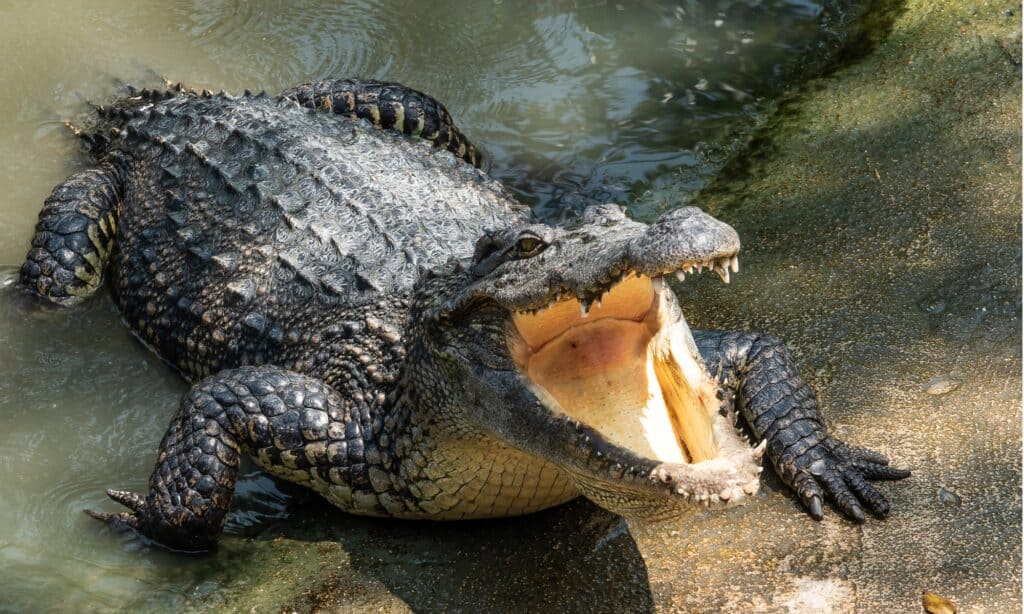
Big aggressive crocodile in the swamp.
©iStock.com/AppleZoomZoom
Distribution and Habitat
Crocodiles are found in a variety of wetland habitats throughout the warmer tropical waters in the southern Hemisphere. Their inability to internally regulate their body temperature means that they rely heavily on the sun to warm their bodies up after it being cooled by spending time in the water.
Americas
The American Crocodile is the largest crocodilian species in North and South America and is found inhabiting freshwater rivers and lakes, along with brackish coastal waters near estuaries and in lagoons from southern Florida, throughout Central America and into northern parts of South America.
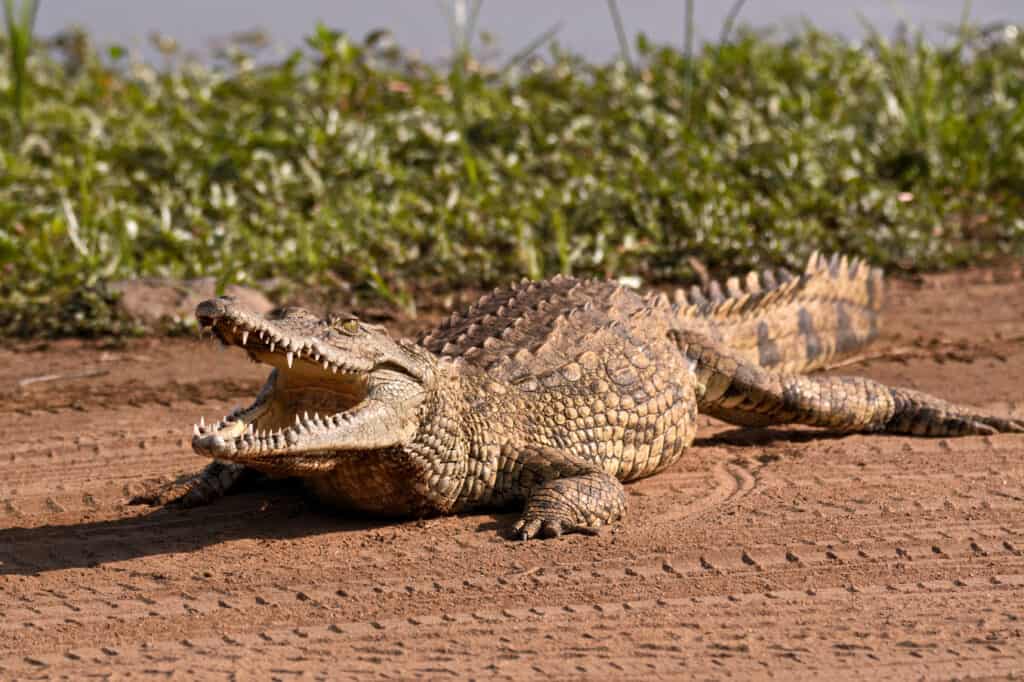
Young Nile Crocodile basking on the banks of a river
©iStock.com/Robby_Holmwood
Africa
Over in Africa, the Nile Crocodile was once widespread in eastern and southern Africa but are now scarcer. They inhabit freshwater marshes, rivers, lakes and mangrove swamps. The world’s largest and most widely dispersed crocodile species is the estuarine crocodile.
Asia and Australia
These formidable reptilian giants are found in river mouths and brackish swamps from the Bay of Bengal in the Indian Ocean, across to and throughout Southeast Asia and down into Australia.
Behavior and Lifestyle
Crocodiles have been extensively studies by many researchers and scientists to understand their behavior better. Although many species are mainly reclusive and haven’t been extensively studied, here are some common behavioral patters found in crocodiles.

Crocodiles bake in the sun during hot daylight hours to prepare for a night of hunting.
©Khalil Ahmed/Shutterstock.com
Inability to regulate Body Temperature
In the same way as other reptiles, crocodiles are not able to regulate their body temperature themselves and instead rely heavily on the heat of the sun to warm their enormous bodies. During the hot daylight hours, they bask in the sun on the riverbanks warming their bodies up from a night of hunting. Smaller species like the dwarf crocodile (which is the least-known of the crocodile species) are also known to climb trees in order to bask on the branches.
Another way crocodiles are able to regulate their body temperature is by bobbing up and down in the water, warming in the sun on the surface and cooling themselves down beneath it. Crocodiles are highly sociable animals that remain together in large, mixed groups of adults and juveniles.
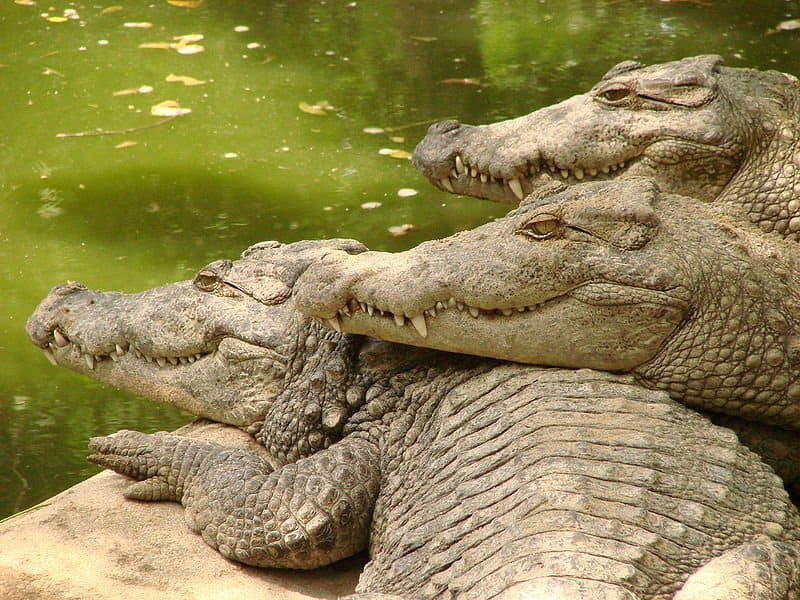
Crocodiles are social animals with a hierarchy led by the largest male.
©Adam Jones Adam63 / CC BY-SA 3.0 – License
Crocodiles are Social Animals
Behavior such as hierarchy, and group feeding have been observed in many of the species. The biggest male is on the top of the hierarchy ladder, and they get to enjoy the best spots for basking. The females always get preference during group feedings when a large animal has been felled by the group. This behavior has especially been observed in the Nile crocodiles and the Mugger crocodiles.
This changes when the mating season begins, the males become highly territorial and protect their stretch of river bank from intrusion by competitors by rearing their large heads high up into the air and roaring at intruders. When female Nile crocodiles are attracted by these noises, the males begin to thrash their bodies around and even shoot water into the air from their nostrils.
How do Crocodiles Communicate?
Unlike many other reptiles crocodiles have the ability to communicate with each other. Depending upon the species in question, the size, the sex, and the situation or condition they are in, crocodiles make a variety of sounds to communicate. Here are some common sounds and their meaning:
- Chirping – When the eggs are about to hatch, the hatchlings inside the eggs make a ‘squeaky’ noise which prompts the mother to carry the eggs into the water with her mouth. The eggs then hatch in the water and the mother keeps the hatchlings in the water, protecting and feeding them over a period of time.
- Distress – When the young crocodiles are in imminent danger or they feel threatened, they emanate a high-pitched sound that can alert other crocodiles in the area.
- Hiss – When they want to threaten others, whether crocodiles or other animals and prey, they make a sound akin to a coughing noise.
- Mating call – female crocodiles make a specific noise called the hatching call.
- Bellowing – The male crocodiles make a bellowing noise which is a combination of an infrasonic vibration that creates ripples in the water and a vibration in the ground itself. This commonly happens during mating season in spring. Crocodiles also use this noise to scare off other predators and threats in the area.

Crocodiles are intelligent creatures who study behavior patterns of prey animals before they attack.
©iStock.com/Maryna Rayimova
Cognitive Intelligence
Crocodiles are highly observant and they study the behavior of their prey extensively. They study the usual patterns in the behavior of animals that come to drink water near their habitat. Some crocodiles have used nesting materials to lure birds close enough to grab them.
Crocodiles are cooperative-group-hunters. They swarm larger preys while big crocodile holds it down and others kill it by ripping it apart. They also trap fish by circling them in groups and snatching them one by one.
Crocodiles are have displayed playful behavior common in social structures, such as locomotive play like repetitive rolling on the slopes, playing with objects, social play like wrestling, swimming and riding ach others backs are common sight in crocodile societies.
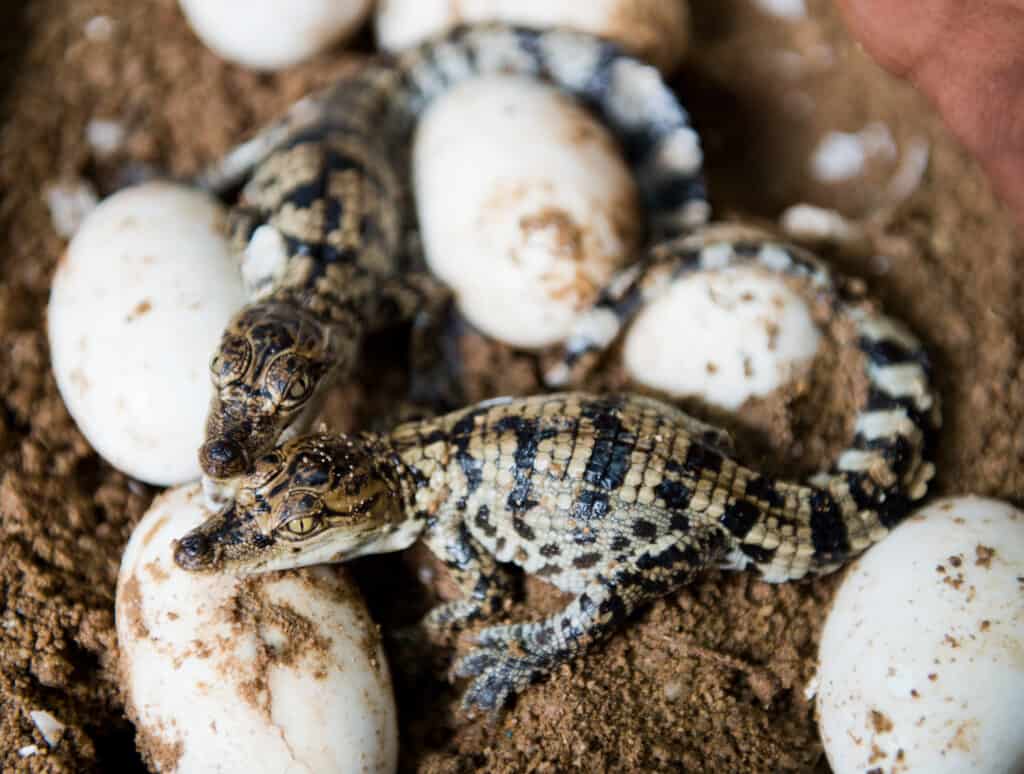
Newly hatched crocodiles often emerge at the start of the rainy season
©hxdbzxy/Shutterstock.com
Reproduction and Life Cycles
After mating, the female crocodile lays between 17 (dwarf crocodiles) and 100 (Nile crocodiles) eggs in a nest made up of soil and vegetation such as leaves, which prevents the eggs from becoming too cold should the nest become flooded during incubation. In areas prone to flooding, they are also known to build nest mounds to raise the eggs out of the danger from flood waters.
The incubation period is usually around 3 months long with hatchlings often emerging to coincide with the beginning of the rainy season to prevent their bodies from drying out. Despite their fearsome reputation, female crocodiles are incredibly caring mothers and guard their nests fiercely to protect them from predators until they are ready to hatch. Once the hatchlings begin to emerge, the female crocodile then helps them down to the water by carrying them in the throat pouch in her mouth.
Interestingly the thin-shelled, leathery eggs of crocodiles (and indeed other more modern reptile species) was an evolutionary breakthrough for many species as their protective layer and waterproof nature meant that females could lay their eggs on land rather than in water, even in the driest of places, meaning they could be better protected from predators. Typically, crocodiles have a lifespan of 25 to 75 years.
Diet and Prey
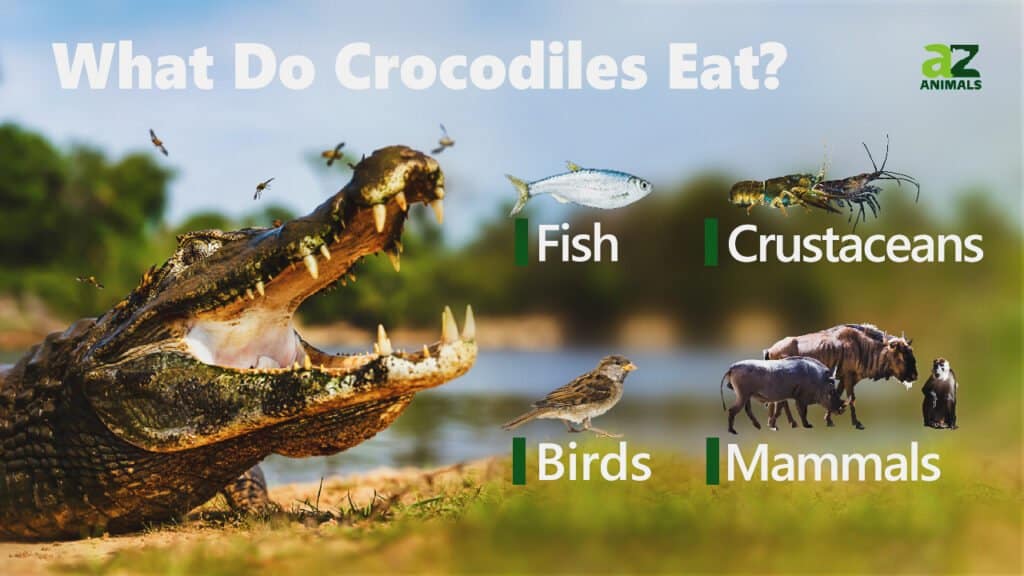
Crocodiles are carnivorous, formidable predators and at the top of the food chain in their natural habitat. Their inability to chew food has led to the development of ambush hunting techniques, and strong powerful jaws with teeth that are used to tear food apart.
- Young crocodiles rely heavily on fish, crustaceans, and small mammals, birds and reptiles, but as they grow larger they are able to take much bigger prey species including, deer, zebra and water buffalo.
- Crocodiles are often more active during the night, with some species being known to venture onto land to catch prey, livestock and in some cases, people (learn more about the most dangerous animals on earth to humans).
- Due to their highly sociable nature, Nile crocodiles (which predominantly feed on fish), are known to work together in order to cordon fish off in sections of river when they are migrating.
- Crocodiles have a very slow metabolism and can float for a long time without moving.
- In extreme cases, they seem to be able to go dormant and live off of their own tissues for long periods.
- Crocodiles can live for up to three years without eating.
Catfish make up a large portion of their natural diets and by keeping their numbers at bay, this allows small fish species to still thrive. These fish (which would ordinarily be quickly eaten by the larger catfish) then provide food for over 40 species of bird, that in return fertilize the waters with their droppings and keep them rich with nutrients so numerous animal species can continue to thrive.
Learn more about the toughest animals in the world here.
Predators and Threats
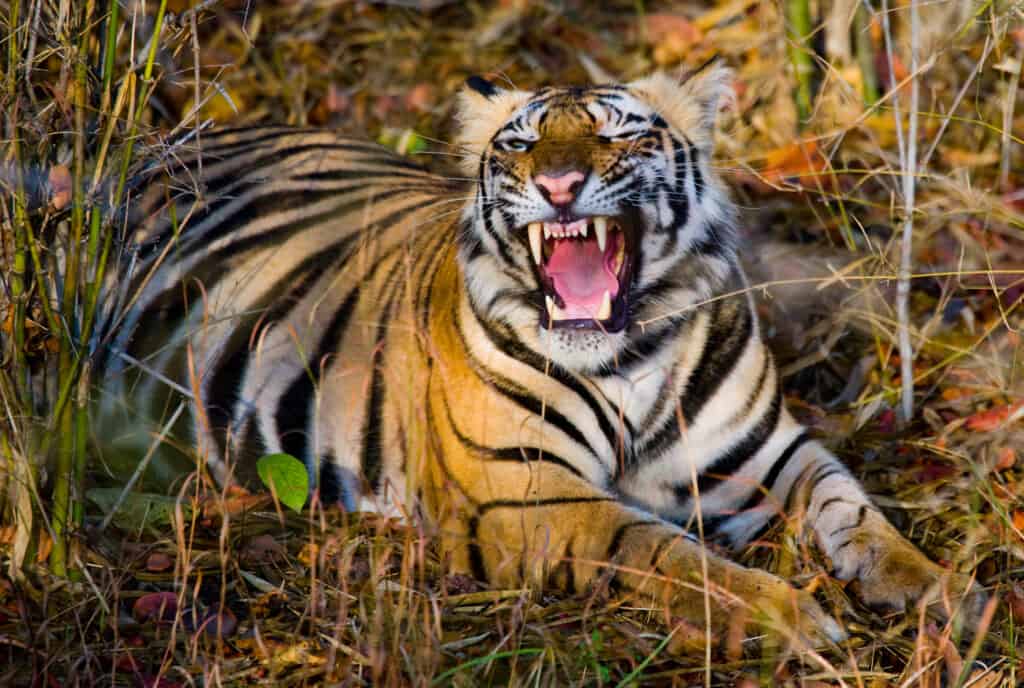
Tigers occasionally prey on crocodiles
©iStock.com/ANDREYGUDKOV
Due to the large size and highly aggressive nature of these apex predators, adult crocodiles have very few predators within their natural environments with the exception of occasional takings by big cats such as lions, jaguars, and tigers. The smaller and much more vulnerable juveniles however are preyed upon by a number of animal species around the world from wild pigs, dogs, and large reptiles to birds of prey like eagles.
Although they are common in certain areas, crocodiles are threatened throughout much of their natural ranges from hunting, habitat loss, and ecological changes further down the food chain due to overfishing or water pollution, which then has an impact on them higher up the food chain.
Interesting Facts and Features
Although most crocodile species inhabit freshwater regions such as swamps, rivers, and lakes, there are a number of species that venture into more salty waters around the coasts. American crocodiles are often found in estuaries and lagoons close to the shores but are able to deal with the higher salinity levels by drinking large amounts of freshwater whenever possible, and by removing salt from the body by secreting crocodile tears through the glands on their face.
In periods of drought, they are also known to burrow deep into the mud in order to stop their bodies from drying out and will not eat anything until the water returns. On the other side of the world, estuarine crocodiles have been observed eating pebbles found on the riverbeds. The process of this is thought to help to grind up their food, therefore aiding digestion but also acts as a ballast to help with buoyancy while floating on the surface of the water.
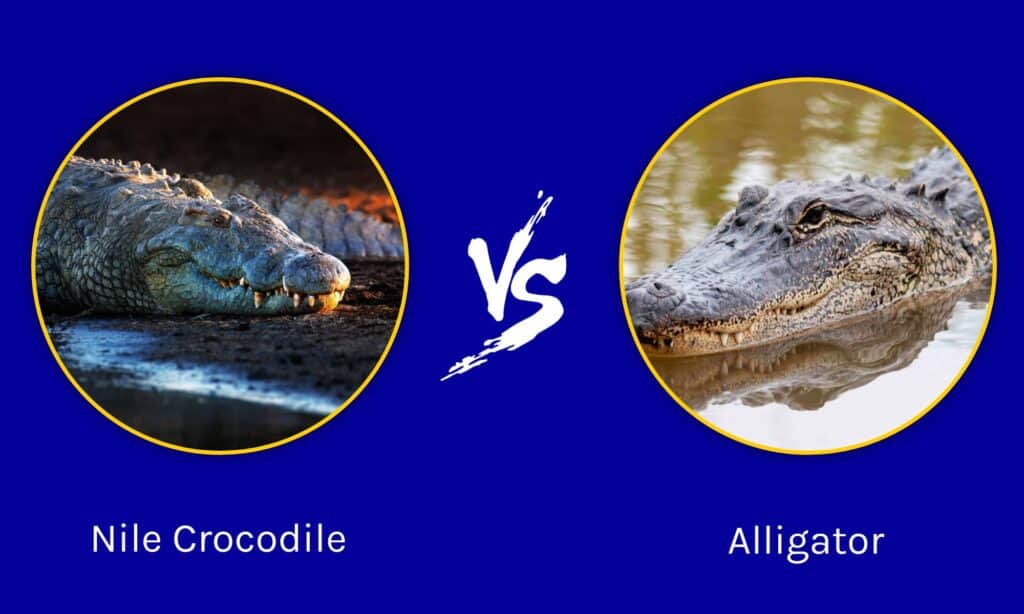
Crocodile vs Alligator
As noted earlier, the order Crocodilia encompasses crocodiles, alligators, gharial, and caimans. With alligators being common across the Southeastern United States, a common question is what are the key differences between alligators vs. crocodiles? The two differ most in that:
- Crocodiles have a more pointed (V-shaped) snout while an alligators’ is ‘U-shaped.’
- Crocodile species such as saltwater crocodiles can grow much larger than American alligators.
- American alligators lack a salt gland and primarily live in freshwater while American crocodiles are far more adaptable to saltwater environments.
Relationship with Humans
The relationship between crocodiles and people has been a long-lasting point of contention for thousands of years. Their highly aggressive manner of attacking prey has resulted in numerous human fatalities an on annual basis, with some people actually having been hunted by crocodiles as well as in ambush on the banks of the rivers.
Although death toll numbers are declining due to better education and local knowledge about the formidable nature of these enormous reptiles, around 1,000 deaths are still estimated to occur every year. Crocodiles have also been affected heavily by increasing human activity in many regions around the world, with the expansion of settlements and an increase in river traffic due to hunting, fishing, and tourism.
Commercial Use of Crocodiles
Crocodile skin – As formidable as they are crocodiles are farmed in many parts of the world for their hide, which is tanned and turned into apparel, shoes, handbags, belts, etc. Crocodile skin is highly sought after and valuable in the high fashion industry across the globe.
Crocodile meat – The meat is harvested as it is considered a delicacy and eaten in various countries such as China, Thailand, Cambodia, Korea, Philippines, New Zealand, Bahamas, and even the USA.
Crocodile oil – Monounsaturated and polyunsaturated fats are extracted from the tissues of the crocodile and sold as crocodile oil. It was extensively used in traditional medicine in many Asian and native cultures. It is used in treating skin conditions, mending wounds and skin tissue, and treating illnesses such as cancer.
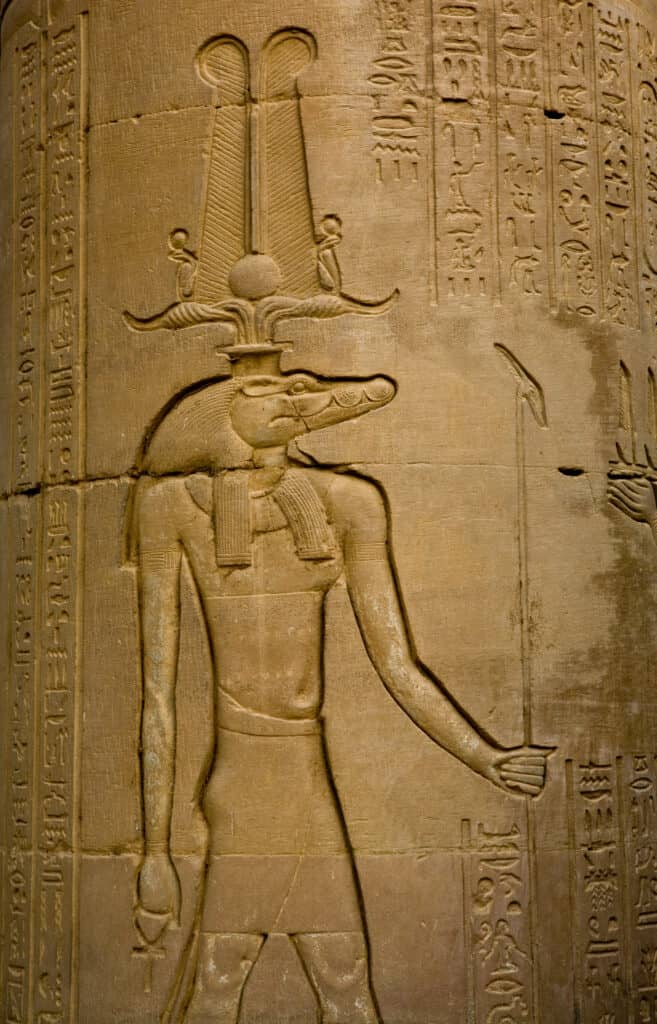
Sobek was the revered Crocodile god of ancient Egypt.
©iStock.com/WHPics
In Various Cultures
The fierce and formidable nature of crocodiles resulted in their being worshipped in many cultures. In Egypt, Sobek, who represents power and fertility has the head of a crocodile. Also, Taweret, the goddess of fertility, has the tail and back of a crocodile on a human body. In parts of Africa, crocodiles are seen as ancestors and offered food. In Hinduism the god and goddess of water are seen riding crocodiles, and so are a few river deities.
Conservation Status
Today, although some local populations are thought to be stable, throughout much of their natural ranges the population numbers for all crocodiles species are declining. Out of the 13 different crocodile species, 6 has been listed as Least Concern, 2 have been listed as Vulnerable and 5 have been listed as Critically Endangered by the IUCN. Of all of these species, the Philippine crocodile is by far the most at risk with less than 200 individuals estimated to remain in the wild
View all 235 animals that start with CCrocodile FAQs (Frequently Asked Questions)
Are Crocodiles herbivores, carnivores, or omnivores?
Crocodiles are Carnivores, meaning they eat other animals.
What Kingdom do Crocodiles belong to?
Crocodiles belong to the Kingdom Animalia.
What phylum do Crocodiles belong to?
Crocodiles belong to the phylum Chordata.
What class do Crocodiles belong to?
Crocodiles belong to the class Reptilia.
What family do Crocodiles belong to?
Crocodiles belong to the family Crocodylidae.
What order do Crocodiles belong to?
Crocodiles belong to the order Crocodilia.
What genus do Crocodiles belong to?
Crocodiles belong to the genus Crocodylus.
What type of covering do Crocodiles have?
Crocodiles are covered in Plate-like scales.
Where do Crocodiles live?
Crocodiles live in North, Central, and South America, Africa, Asia, and Australia.
In what type of habitat do Crocodiles live?
Crocodiles live in rivers, lakes, marshes, lagoons, mangrove swamps, and estuaries.
What are some predators of Crocodiles?
Predators of Crocodiles include humans, large felines, and birds of prey.
What is an interesting fact about Crocodiles?
Crocodiles have changed very little in 200 million years!
What is the scientific name for the Crocodile?
The scientific name for the Crocodile is Crocodylus acutus.
What is the lifespan of a Crocodile?
Crocodiles can live for 20 to 70 years.
What is a baby Crocodile called?
A baby Crocodile is called a hatchling.
How many species of Crocodile are there?
There are 13 species of Crocodile.
What is the biggest threat to the Crocodile?
The biggest threats to the Crocodile are habitat loss and hunting.
What is another name for the Crocodile?
The Crocodile is also called the American crocodile, orinoco crocodile, freshwater crocodile, Philippine crocodile, Mexican crocodile, Nile crocodile, New Guinea crocodile, mugger crocodile, estuarine crocodile, Cuban crocodile, Siamese crocodile, dwarf crocodile, or slender-snouted crocodile.
How many Crocodiles are left in the world?
The population size of the Crocodile is unknown.
How fast is a Crocodile?
A Crocodile can travel at speeds of up to 25 miles per hour.
How do Crocodiles have babies?
Crocodiles lay eggs.
Who would win in a fight: Crocodiles vs. Gorrilas?
In a battle that pitted crocodiles vs. gorillas, a crocodile would likely emerge victorious.
An encounter between a crocodile and gorilla would likely occur on the water’s edge. In that space, the power of a crocodile bite could crush a gorilla and allow the crocodile to drag it underwater.
Who would win in a fight: Crocodiles vs. Bears?
A battle of crocodiles and bears would pit two of the largest predators in the world against each other. While crocodiles would have the advantage near water sources, bears could rival crocodiles in a battle on land.
What's the difference between a crocodile and a caiman?
There are many differences between a caiman and a crocodile, including their species. The appearance and dietary preferences of these reptiles also differ.
Where in the world do crocodiles live?
Crocodiles live in North and South America, Africa, Asia, Australia. They neither live in Europe nor Antarctica.
Do crocodiles live in Florida?
Crocodiles live in Florida, but with a population of less than 3000.
What is a group of crocodiles called?
A group of crocodiles is called a bask.
Who would win a fight between a king cobra and a crocodile?
A crocodile would win a fight against a king cobra. If the king cobra bites the alligator first, it may not have an impact.
The crocodile’s skin is very thick. While the king cobra has fangs that measure 0.5″ inches, that might not be enough to deliver the venom into the crocodiles’ system. Even then, the crocodile can catch the fleeing snake and kill it.
Who would win in a fight: Great White Shark vs. Crocodile?
A great white shark would win a fight against a saltwater crocodile.
These deadly creatures are incredibly powerful, but the great white shark has an amazing advantage in the water. Not only would this animal probably notice the crocodile first, but it also has the speed to land a devastating attack.
Who would win in a fight: Shoebill Storks vs, Crocodiles?
A crocodile would win a fight against a shoebill stork.
The size, power, and brutal ambush techniques of crocodiles give them a massive advantage against these birds.
Who would win a fight: Tiger Shark Vs Crocodile?
A tiger shark would almost always kill a crocodile. Tiger shark wins 9 times out of 10.
In the open water, the tiger shark will always have the advantage over the crocodile. It can swim faster, maneuver better, and breathe underwater. If the fight goes below the water, the tiger shark almost always wins.
Bull Shark Vs Crocodile: Who would win a fight?
We predict that if a bull shark were to meet an American crocodile in the open water, the crocodile would win 6 out of 10 times.
The reason that this battle is so close is primarily due to size. The American crocodile has a significant size advantage over the bull shark, making it tough for the shark to perform a takedown on a full-grown crocodile. Even more, the shark would have to specifically target the underbelly of the crocodile to cause real damage. Any attacks that didn’t hit the underbelly would cause damage, but nothing fatal.
What are the differences between the Nile crocodile and the Saltwater crocodile?
The most significant differences between a Nile crocodile and a Saltwater crocodile are their size, color, and preferred habitats. Saltwater crocodiles are larger than Nile crocodiles on average, weighing between 400 and 1,150 pounds while the Nile crocodile averages between 500 and 910 pounds.
What are the differences between crocodiles, alligators, caiman, and gharials?
Within the order Crocodilia, there are four different types of reptiles that include crocodiles, caiman, alligators, and gharial. The main differences in crocodile vs. alligator vs. caiman vs. gharial is their anatomy, with alligators having ‘u-shaped’ snouts, crocodiles more slender, gharials extremely thin, and caiman a pointy snout. Other differences include size, where they’re found, and reproductive habits.
How to say Crocodile in ...
Thank you for reading! Have some feedback for us? Contact the AZ Animals editorial team.
Sources
- David Burnie, Dorling Kindersley (2011) Animal, The Definitive Visual Guide To The World's Wildlife
- Tom Jackson, Lorenz Books (2007) The World Encyclopedia Of Animals
- David Burnie, Kingfisher (2011) The Kingfisher Animal Encyclopedia
- Richard Mackay, University of California Press (2009) The Atlas Of Endangered Species
- David Burnie, Dorling Kindersley (2008) Illustrated Encyclopedia Of Animals
- Dorling Kindersley (2006) Dorling Kindersley Encyclopedia Of Animals

















